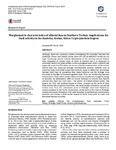Morphometric characteristics of alluvial fans in Southern Turkey: implications for fault activity in the Anatolia, Arabia, Africa Triple Junction Region.
| dc.contributor.author | Karatas, A | |
| dc.contributor.author | Boulton, Sarah | |
| dc.date.accessioned | 2019-04-25T16:25:16Z | |
| dc.date.issued | 2019-03-28 | |
| dc.identifier.issn | 2315-778X | |
| dc.identifier.uri | http://hdl.handle.net/10026.1/13746 | |
| dc.description.abstract |
Although, there are numerous studies investigating the boundary between the Anatolian, African and Arabian plates, there are still no definitive results on this topic. Continuing intense tectonic deformation in the area has caused tectonic lines composed of various types of faults to interact and it is necessary to accurately identify the plate borders in the convergence area which is globally and regionally important. Therefore, the impact of tectonic deformation on the current alluvial fans was measured through morphometric analysis methods such as concavity index, best fitted ellipse and sinuosity index to define the relationship between fault lines by presenting their recent behavior and the findings were evaluated in the light of kinematic-geodetic data. Thus, the relationship between tectonic belts which reflect similar effects had been considered at length by trying to describe the deformation effect of current tectonics on alluvial fans. Results showed that Dead Sea Fault Zone - the border of Arabian-African plates- and Cyprus Arc (CA) -the northern border of Africa- intersect on the north of Amik Plain and that East Anatolian Fault Zone –the south border of Anatolia- was moved further away from this intersection point to Türkoğlu since Late Miocene by Arabia’s motions to the North. Continuation of this fault in the west of Türkoğlu intersected Amanos Mountains with many branches in northeastern-southwestern direction and created a plate border shaped by faults from north to south with decreased tectonic activities. | |
| dc.format.extent | 9-29 | |
| dc.language.iso | en | |
| dc.publisher | Academia Publishing | |
| dc.rights | Attribution-NonCommercial-NoDerivatives 4.0 International | |
| dc.rights | Attribution-NonCommercial-NoDerivatives 4.0 International | |
| dc.rights | Attribution-NonCommercial-NoDerivatives 4.0 International | |
| dc.rights.uri | http://creativecommons.org/licenses/by-nc-nd/4.0/ | |
| dc.rights.uri | http://creativecommons.org/licenses/by-nc-nd/4.0/ | |
| dc.rights.uri | http://creativecommons.org/licenses/by-nc-nd/4.0/ | |
| dc.title | Morphometric characteristics of alluvial fans in Southern Turkey: implications for fault activity in the Anatolia, Arabia, Africa Triple Junction Region. | |
| dc.type | journal-article | |
| plymouth.issue | 3 | |
| plymouth.volume | 7 | |
| plymouth.journal | Academia Journal of Environmental Sciences | |
| dc.identifier.doi | 10.15413/ajes.2019.0104 | |
| plymouth.organisational-group | /Plymouth | |
| plymouth.organisational-group | /Plymouth/Faculty of Science and Engineering | |
| plymouth.organisational-group | /Plymouth/REF 2021 Researchers by UoA | |
| plymouth.organisational-group | /Plymouth/REF 2021 Researchers by UoA/UoA07 Earth Systems and Environmental Sciences | |
| plymouth.organisational-group | /Plymouth/Users by role | |
| plymouth.organisational-group | /Plymouth/Users by role/Academics | |
| dcterms.dateAccepted | 2019-03-28 | |
| dc.rights.embargodate | 2019-9-13 | |
| dc.rights.embargoperiod | Not known | |
| rioxxterms.version | Accepted Manuscript | |
| rioxxterms.versionofrecord | 10.15413/ajes.2019.0104 | |
| rioxxterms.licenseref.uri | http://creativecommons.org/licenses/by-nc-nd/4.0/ | |
| rioxxterms.licenseref.startdate | 2019-03-28 | |
| rioxxterms.type | Journal Article/Review |



